- DOLMEN
- A type of single chamber Megalithic stone tomb originally (that is before excavation) buried within
a mound.
![[example]](../images/v/vx-de-lg-01-ol.gif)
![[example]](../images/v/vx-pt-mcdss.gif)
![[example]](../images/v/vx-pt-vrlmo.gif)
Flag of Oldendorf upon Luhe, Germany;
Flag of Salselas, Portugal;
Flag of Mondrôes, Portugal
- DOMINICAN CROSS
- A cross fleury gyronny and symbol of the Dominican Order
– a cross of the Order of Santo Domingo or of St Dominic – see
cross fleury and
cross gyronny with its following note (also
cross counterchanged).
![[example]](../images/v/vx-es-av-al.gif)
Flag of Aldeanueva de Santa Cruz, Spain
- DOORED
- A word used in some heraldic blazoning to describe the entrance of a castle, tower or other building,
but see port and the note below.
![[Wolhusen]](../images/v/vx-ch-lu077.gif)
Flag of Wolhusen, Switzerland
Please note that, as far as the Editors can discover, this extension of an existing term has no
heraldic justification.
- DOPPELKREUZ
- See double-beamed cross 2).
![[example]](../images/v/vx-ch-sg072.gif)
Flag of Degersheim, Switzerland
- DOUBLE APPLIQUÉ
- A term that may be used when the appliqué technique is applied to both sides of a flag –
see appliqué (also
single appliqué).
- DOUBLE-BEAMED (or DOUBLE-ARMED) CROSS
- 1) See cross of Lorraine.
2) A less ambiguous interpretation of the German term Doppelkreuz
– see double cross 2).
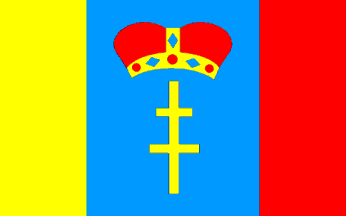
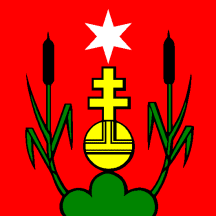
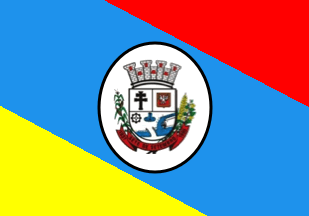
Flag of Busko-Zdrój county, Poland;
Flag of Oberrohrdorf, Switzerland;
Flag of Sete de Setembro, Brazil
- DOUBLE BORDER
- A term that may be used when a flag has two borders – but see
inner border 1) and
outer border.
![[example]](../images/v/vx-gr-mh-a2.gif)
Former Flag of Vistonida, Greece
- DOUBLE COTTICED (or COTISED)
- In heraldry see cotticed 2).
![[example]](../images/v/vxt-d1164b.gif)
- DOUBLE CROSS
- 1) See Cross of Lorraine.
2) A direct translation of the German term Doppelkreuz – but see the note below.
3) The colloquial term for a treacherous act, and (appropriately) used in one instance to
illustrate the charge on a fictitious flag as shown below –
see twin saltires.
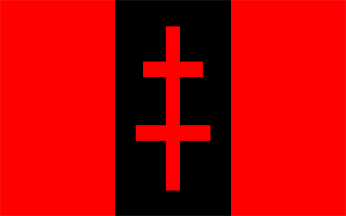
sk.gif)
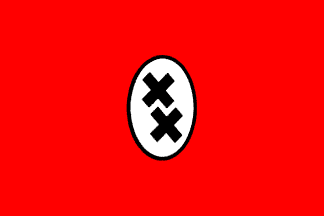
Flag and Arms of Skaryszew, Poland;
National Flag of the fictitious country Tomania from the film
"The Great Dictator"
Please note regarding 2) that this term is (as may be seen above) slightly ambiguous, and therefore, the
Editors suggest use of the phrase “double-armed cross” as being more accurate.
- DOUBLE-FIMBRIATED
- See cotticed 1) and its following note (also
fimbriated).
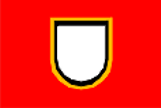
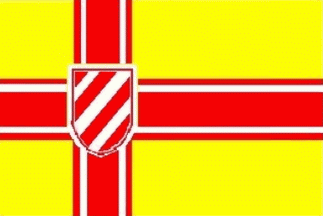
Example; Flag of Rudervereinigung Hellas-Titania, Germany
- DOUBLE PAVON (or DOUBLE PENNANT)
- Alternative terms for the shape of the national flag of Nepal, which was apparently created by two
pavon-style pennants having been sewn together – see pavon
(also pennant).

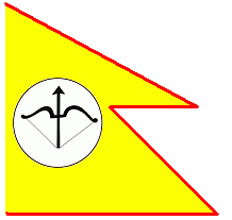
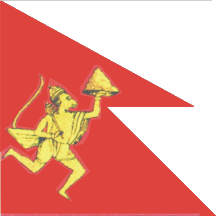
National Flag of Nepal; Flag of
Kirat, Nepal; Former Princely State of
Dewas, India
Please note regarding the main heading above, that these terms have been introduced by the
Editors as a more accurate alternatives to that already introduced.
- DOUBLE-POINTED
- A term for the variation of a swallow-tailed flag where a vertical section appears
in the centre of the fly, such as that which appears on the state flag of Iceland, the yacht ensign of
the Aaland Islands or on various Danish flags – see splitflag and
swallow-tail(ed) (also triangular-tongued).
![[double-pointed]](../images/v/vx-dk_state.gif)
![[double-pointed]](../images/v/vx-dk~cu.gif)
![[double-pointed]](../images/v/vx-dk~s.gif)
Danish Flags: State Flag/Naval Ensign,
Customs Flag and
State Ensign
- DOUBLE-PRINCE
- The term for a 17th century Dutch naval flag usually (but not invariably) of six even, horizontal
stripes in the Dutch national colours repeated – but see
triple-prince (also
dreikleur and
princeflag).
![[double prince]](../images/v/vx-nl-pr2a.gif)
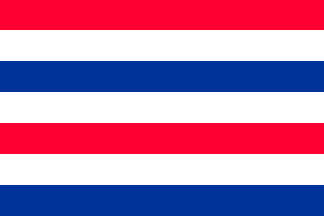
From left: Double Prince c1660; With
Seven Stripes c1660
Please note however, whilst all available evidence suggests that red, white and blue were
employed, orange instead of red may have been used at an earlier stage.
- DOUBLE QUEUED
- The term sometimes used when a lion is showing a split tail, instead of
the correct heraldic description queue fourché or
fourchée (see also coward,
fourché and queued).
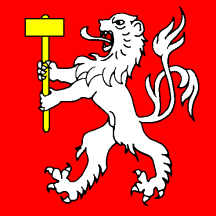
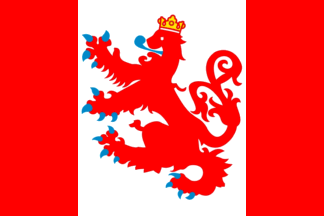
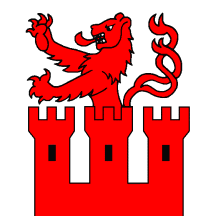
Flag of Martigny, Switzerland;
Flag of Sankt Vith, Belgium;
Flag of Muttenz, Switzerland
- DOUBLE-SIDED
- 1) The term used when a flag is made from two separate pieces of cloth placed back to back,
either to ensure that the reverse of a flag is not a mirror image of the obverse (as in the
National Flag of Saudi Arabia) or (in the case of some military colours and others) is of a
different design (see also
mirror image,
obverse and
reverse).
2) See two-sided 1).
![[double-sided example]](../images/v/vx-es^con-o.gif)
![[double-sided example]](../images/v/vx-es^con-r.gif)
Obverse and Reverse, Colour of The Condor Legion, Spain 1939
- DOUBLE-SWALLOWTAIL
- See swallowtail and tongue
and triple-tailed 1).
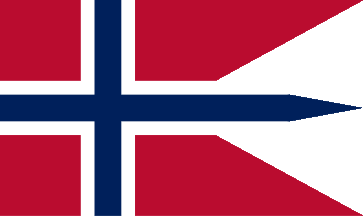
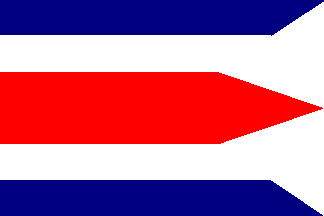
State Flag of Norway; Flag of
Dolná Strehová, Slovakia
- DOUBLE-TAILED
- 1) In heraldry see queue fourché
also double queued).
2) In vexillology see swallow-tailed).
![[double tailed]](../images/v/vx-cz-kv.gif)
![[double tailed]](../images/v/vx-ch-vs076.gif)
![[double tailed]](../images/v/vx-sk-barde.gif)
Flag of Karlovy Vary Region, Czechia 2004–2011;
Flag of Martigny, Switzerland;
Flag of Bardejov City, Slovakia
- DOUBLE-TAILED DESCATE
- (adj) A term used to describe a fly that is cut into two tails with rounded
ends – a cloven bullnose (see also fly,
gonfanon,
guidon 2),
multi-tailed descate,
heraldic standard,
swallowtail and
triple-tailed descate).
![[double tailed descate]](../images/v/vxt-d123.gif)
Double-Tailed Descate (CS)
- DOUBLE-TRESSURE
- The heraldic term for a double border inset from the edges of a shield,
banner of arms or flag – see
double tressure fleury counter fleury.
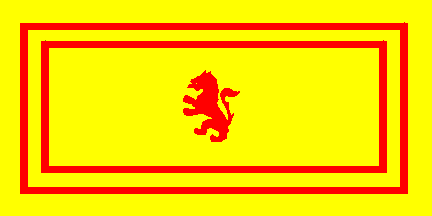
Flag of
McIlwraith, McEacharn & Co., UK
- DOUBLE-TRESSURE FLEURY COUNTER FLEURY
- The heraldic phrase for a decorated, double border inset from the edges of
a shield, banner of arms or flag, with a well-known example being that on the
royal banner and arms of Scotland – see double tressure
(also
border,
counter-,
fleur-de-lis,
fleury,
inset border and
orle).

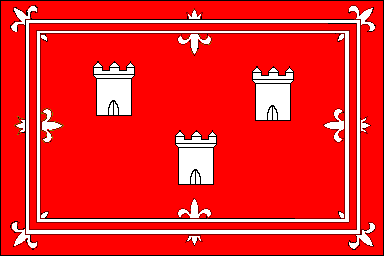
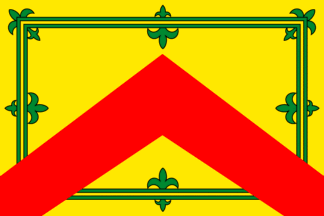
Royal Banner of Scotland;
Flag of Aberdeen, Scotland;
Flag of Horebeke, Belgium
Please note that the term “tressure” is considered by some heraldic writers to be a
diminutive of ‘orle’ but is rarely seen singly – see tressure.
- DOUBLEMOUNT (or DOUBLE MOUNT)
- In heraldry see coupeau and mount.
.gif)
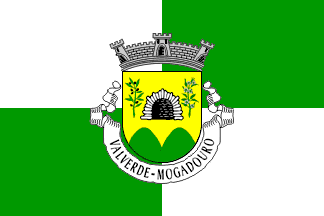
Arms and Flag of Valverde, Portugal
- DOVETAILED
- The heraldic term used to describe the edge of an ordinary, or division line within the arms, that is
shaped like the woodworking joint of that name – lambeau (see also
embattled).
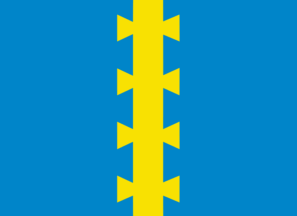
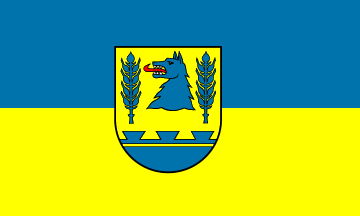

Flag of
Stordal, Norway;
Flag of Wendeburg, Germany;
Flag of Etne, Norway
- DRACO
- A Late Roman cavalry flag formed like a windsock whose open end was fixed to a dragon’s head
with gaping silver jaws (see also draconarius,
dragon flag 1)
and windsock).

Kingdom of Dacia
- DRACONARIUS (or DRACONTARIUS)
- A bearer of the draco – see draco.

(Wikipedia)
- DRAGON
- In heraldry and vexillology, a generic term for an often (but not
invariably) winged mythological creature that is sometimes shown breathing
fire – but see wingless dragon
and the note below (also dragon flag
and heraldic beasts).
-
![[dragon]](../images/v/vx-gb-e-wsx.gif)
![[dragon]](../images/v/vx-gb-e-som-fir.gif)
![[dragon]](../images/v/vx-no-17-14.gif)
Flag of Wessex, UK; Flag of
Somerset, UK; Flag of
Stjørdal, Norway
Please note that the strict rules (in both English and Continental European heraldry) regarding
use of this term are often not observed, and that it can cover a wide variety of mythological creatures
– a basilisk, cockatrice, lindworm or wyvern, etc. – with the exactly defined distinctions
between them often (officially) ignored.
- DRAGON FLAG
- 1) A pre-heraldic flag similar to the Roman Draco formed like a windsock,
with a dragon's head/shape, and possibly having a whistling tube within it –
see draco(also
dragon,
pre-heraldic,
standard 6) and
windsock).
- 2) See imperial dragon flag.
![[imperial China dragon flag]](../images/v/vx-cn_1890.gif)
Chinese Imperial Dragon Flag c1890
Please note with regard to 1), it is suggested by
some authorities that the main standard used by the Saxons at the Battle of
Hastings (in 1066) was of this type.
- DRAPING
- (v) The decoration of a staff with a black cravat or long black ribbons (particularly
but not exclusively on flags that cannot be half-masted) as a sign of mourning –
a mourning ribbon – but see
cravat 2)
(also cravat 1,
half-mast a flag and
staff 2)).
![[draped flag]](../images/v/vx-es_mrn2.gif)
National Flag of Spain Draped with a Mourning Ribbon
- DRAPISTICS
- An alternative term, proposed but never adopted, for the study of flags – see
vexillology.
- DRESS FLAG
- See indoor flag.
![[dress flag]](../images/v/vx-us^secar.gif)
Dress/Indoor Flag of the Secretary of the Army, US
- DRESS KNOT
- A decorative knot of cord (occasionally leather), possibly displaying the national colours or braided
in gold/silver with or without contrasting thread, and attached to the sword – a port epee
or sword knot (see also aiguillette).
![[dress knot]](../images/v/vx-swordknot.jpg)
Officer’s Dress Knot, USN and USCG (marlowwhite.com)
Please note that the dress or sword knot is a decorative
reminder of the lanyard, which in this instance ran from a sword’s guard to its user’s wrist,
and could be worn (particularly, but not exclusively, by officers of the navy or cavalry) in
order to prevent any loss during combat.
- DRESS SHIP, TO
- 1) (v) Generally, the practice of decorating a naval vessel for special occasions, such as
national days, whilst berthed alongside or at anchor, by stringing dressing lines
between the masts (and down to the ensign and jack staffs), and with national
flags at the mastheads – dressing ship, dressing overall or full dressing (see
also national flag,
dressing lines
ensign staff,
jack staff and
masthead).
- 2) (v) Specifically, in US naval usage, the practice of decorating a warship during lesser
commemorative occasions, whilst berthed alongside or at anchor, by displaying
the ensign and jack together with an ensign at each masthead, but without the
dressing lines – but see dressing overall 2) (see also
dressing lines,
masthead,
"naval ensign" under ensign and
"naval jack" under jack).
- 3) (v) Specifically in British Royal Navy and some other naval usage, the practice of decorating
a warship with jack, ensign and masthead flags/ensign(s) but without the dressing lines, when
underway within sight of a port or anchorage during dress ship occasions – but see
dressing overall 3).
- 4) (v) The practice of merchant vessels (especially passenger liners) and
yachts to decorate themselves with strings of dressing lines on special occasions
such as maiden voyage departure and arrival, or on other occasions ordered by the
shipping company or club.
Notes
a) Warships not directly involved
in the occasion being celebrated, but who are berthed in the presence or in sight
of ships that are, will also dress as a courtesy according to the local practice,
using the ensign or national flag of the celebrant at the main masthead in lieu
of their own ensign or national flag.
b) This is a continuation of
the earlier maritime practice (dating from at least the 16th century) of hanging
out every flag available by way of celebration, but that in modern navies and
some merchant marine companies both the occasions for display and the make-up
of dressing lines is strictly regulated (with this last being confined to signal
flags only).
- DRESSED
- 1) In heraldry see garnished,
clad,
habited and
vested.
2) In vexillology see dress ship, to.
![[dressed]](../images/v/vx-ch-be222.gif)
![[dressed]](../images/v/vx-pt-tvrcc-ct.gif)
![[dressed]](../images/v/vx-ch-sg008.gif)
Flag of Münchenwiler, Switzerland;
Flag of Cabanas de Tavira, Portugal;
Flag of Rieden, Switzerland
- DRESSING LINES
- Signal flags and pennants made up in decorative strings according to the
size and configuration of ship they are to be used on and also according to
ordered patterns laid down by naval authorities in the case of warships, or
commercial companies in the case of merchant vessels – rainbow lines – see
dressing overall (also
dress ship, to 1) and
dress ship, to 4)).
- DRESSING OVERALL (or DRESSED OVERALL)
- 1) See dress ship, to 1) and
dress ship, to 4).
- 2) (v or adj) In US naval usage the practice of decorating a vessel for major
commemorative occasions, whilst berthed alongside or at anchor, by stringing dressing
lines between the masts (and down to the ensign and jack staffs), and with a jack and
ensign at the bow and stern, and national flags at the mastheads – but see
dress ship 2).
- 3) (v or adj) In British Royal Navy and some other usage decorating a vessel for
commemorative occasions, whilst berthed alongside or at anchor, by stringing dressing
lines between the masts (and down to the ensign and jack staffs), and with a jack and
ensign at the bow and stern, and national flags at the mastheads – but see
dress ship 3).
![[dressing ship example]](../images/v/vxt-d611.gif)
A Warship of the South African Navy Dressed Overall (Andries Burgers)
- DRESSING SHIP
- See dress ship, to 1) and
dress ship, to 4).
- DRIEKLEUR
- The national flag of The Netherlands – see tricolour 2)
(also double prince,
Dutch colours 1),
princeflag and and triple prince).
![[Netherlands flag]](../images/v/vx-nl.gif)
National Flag of The Netherlands
- DRUM BANNER
- See bannerette and
war banner.
- DUTCH COLOURS
- 1) The term used when the colours and/or design of a flag is (or was) based upon the Dutch driekleur
and/or princeflag – see driekleur and
princeflag.
2) See pan-Slavic colours with its following note.
3) See colours 2).
![[Transvaal]](../images/v/vx-za-trans.gif)
![[Orange Free State flag]](../images/v/vx-za-orang.gif)
![[South Africa flag]](../images/v/vx-za-1928.gif)
Flag of The
Transvaal 1857–1902; Flag of The
Orange Free State 1856–1902;
National Flag of South Africa 1928–1994.
Please note with regard to 2, that (despite the inclusion of orange) some
sources list these with the pan-Slavic colours.
![[example]](../images/v/vx-de-lg-01-ol.gif)
![[example]](../images/v/vx-pt-mcdss.gif)
![[example]](../images/v/vx-pt-vrlmo.gif)
![[example]](../images/v/vx-es-av-al.gif)
![[Wolhusen]](../images/v/vx-ch-lu077.gif)
![[example]](../images/v/vx-ch-sg072.gif)



![[example]](../images/v/vx-gr-mh-a2.gif)

sk.gif)






![[double-pointed]](../images/v/vx-dk_state.gif)
![[double-pointed]](../images/v/vx-dk~cu.gif)
![[double-pointed]](../images/v/vx-dk~s.gif)
![[double prince]](../images/v/vx-nl-pr2a.gif)




![[double-sided example]](../images/v/vx-es^con-o.gif)
![[double-sided example]](../images/v/vx-es^con-r.gif)


![[double tailed]](../images/v/vx-cz-kv.gif)
![[double tailed]](../images/v/vx-ch-vs076.gif)
![[double tailed]](../images/v/vx-sk-barde.gif)




.gif)




![[dragon]](../images/v/vx-gb-e-wsx.gif)
![[dragon]](../images/v/vx-gb-e-som-fir.gif)
![[dragon]](../images/v/vx-no-17-14.gif)
![[imperial China dragon flag]](../images/v/vx-cn_1890.gif)
![[draped flag]](../images/v/vx-es_mrn2.gif)
![[dress flag]](../images/v/vx-us^secar.gif)
![[dressed]](../images/v/vx-ch-be222.gif)
![[dressed]](../images/v/vx-pt-tvrcc-ct.gif)
![[dressed]](../images/v/vx-ch-sg008.gif)
![[dressing ship example]](../images/v/vxt-d611.gif)
![[Netherlands flag]](../images/v/vx-nl.gif)
![[Transvaal]](../images/v/vx-za-trans.gif)
![[Orange Free State flag]](../images/v/vx-za-orang.gif)
![[South Africa flag]](../images/v/vx-za-1928.gif)

![[example]](../images/v/vxt-d1164b.gif)
![[double tailed descate]](../images/v/vxt-d123.gif)


![[dress knot]](../images/v/vx-swordknot.jpg)